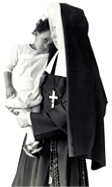

Quebec, Canada
 |
Social Works
| In 1850, St. Magdalen’s Refuge, the first ministry directed by Marie-Josephte Fitzbach, received women released from jail. Later, the fledgling community continued to respond to the needs of society concerning a particular clientele: women prisoners, orphans, women and teenage girls in difficulty, single mothers and their children. |
| In the early 1980s, the era of extensive social works and large schools seemed finished, but the mission of the sisters did not end there. They became involved in new ministries, some led by the Congregation, others in partnership with other religious communities and organizations offering help to persons who were lonely and/or in need. Today, the sisters offer assistance especially to women in need.
|
List of Social Works
|
|
On January 11, 1850, Mrs. Roy and her companion, Mary Keogh, opened the Asile de Ste-Madeleine at 67 Richelieu Street, as a shelter for women leaving prison. During the years, the clientele changed. At its closure in 1975, the Maison Marie-Fitzbach, as it was renamed in 1962, received young women aged 13 to 18 who had personal and/or family problems. |

View on map |
|
|
In 1870, the Good Shepherd opened a reform school for little girls and teenagers who were troubled or in need of protection. This ministry, called the Hospice St-Charles as of 1876, received its last teenage girls in 1965. In 1975, after a few years’ closure, the house became a residence for the sisters. |

View on map |
|
|
In the mid-1800s in Quebec City, single mothers gave birth to their babies at the Marine Hospital or in jail. In the 1870s, two physicians obtained from Archbishop Elzéar-Alexandre Taschereau the authorisation to open a maternity clinic on Couillard Street, to be directed by the Good Shepherd Sisters. This work of Mercy received single mothers without distinction of race, religion or nationality, as of September 8, 1874. In 1929, the Hôpital de la Miséricorde moved to Ste-Foy Road. A government decision ended its activities on December 31, 1972. From 1874 to 1972, this Mercy Hospital recorded 46,122 admissions and 36,780 deliveries. Case files of single mothers were transferred to the Provincial youth centre. Programme Retrouvailles et recherche des antécédents du CIUSSS de la Capitale-Nationale. |

View on map |
|
|
Until 1901, children born at the Hospice de la Miséricorde were entrusted to the sisters at l’Hôpital du Sacré-Cœur-de-Jésus in Quebec City. In response to a request from Archbishop Louis-Nazaire Bégin, the Good Shepherd opened a facility for children born outside marriage. After lodging at the Mother House, then successively on Des Remparts, Ferland and Couillard Streets, the foundling home moved to Ste-Foy Road on July 6, 1908. As of the 1960s, more liberal customs and a new tolerance prompted many single mothers to keep their babies. This factor among others led to the closure of the Crèche on December 31, 1972. The personnel of that institution had cared for 38,672 children and facilitated the adoption of 26,276 among them. Case files of adopted children were transferred to the Provincial youth centre: Programme Retrouvailles et recherches des antécédents du CIUSSS de la Capitale-Nationale. The building became a residence for the sisters from 1973 to 2008. It also housed the Externat St-Jean-Berchmans from 1974 to 2003. |

View on map |
|
|
On leaving the Hospice St-Charles, many boarders had no other home. In 1916, the Good Shepherd opened the Patronage Ste-Geneviève for them. Here, young women followed courses in home economics to help them find work. This establishment offered courses until 1968. Moreover, from 1942 to 2003, young working women and college and university students were received as boarders. |

View on map |
|
|
In 1925, in order to offer a more stimulating context to the children of the Crèche St-Vincent-de-Paul who had not been adopted, the Good Shepherd opened the Hospice des Sts-Anges. Until 1962, this home also received other orphans as well as children from families temporarily in difficulty. |

View on map |
|
|
Until 1931, Quebec City had no women’s prison. The Quebec Government decided to build the Refuge Notre-Dame-de-la-Merci, called Maison Gomin in 1968. The Good Shepherd Sisters were entrusted with its direction and lived on the premises from 1931 to 1973. One sister remained director of the prison until 1981, and another was a peace officer until its closure in 1992. |

View on map |
|
|
In 1933, the Congregation opened the Orphelinat du Sacré-Cœur in the city of Rivière-du-Loup to receive orphans from that region. From 1970 until its closure in 1976, the establishment served as a transition home for adolescent girls in difficulty. From 1982 to 2002, the Maison Sacré-Coeur became an authorized residence for the elderly. |

View on map |
|
|
In 1938, in Hawkesbury near Ottawa, the Congregation opened the Hôpital St-Cœur-de-Marie to receive single mothers of the region. Married women could also give birth to their babies here as of 1943. The Good Shepherd Sisters left Ontario in 1970. |

View on map |
|
|
Until 1943, teenage girls experiencing socio-emotional difficulties had to go to a rehabilitation centre in Montreal. That year, at the request of Cardinal Jean-Marie Rodrigue Villeneuve, O.M.I., the Congregation accepted to open the Maison Notre-Dame-de-la-Garde in Cap-Rouge. In 1975, as a result of government changes to merge institutions, a new reform school, L’Escale, opened its doors. It received the young women from Maison Notre-Dame-de-la-Garde and from Maison Marie-Fitzbach. |

View on map |
|
|
From 1948 to 1962, the Congregation received at the Maternelle Marie-au-Temple children with special needs from the foundling home. |

View on map |
|
|
To improve the care given to babies, the Good Shepherd opened a school of child care nursing, the École de Puériculture, on February 16, 1948. This school was part of the Crèche St-Vincent-de-Paul. Until its closure in 1971, the most modern techniques available in child care were taught there. Because of the added services of graduate child care nurses, the Crèche recorded a major decrease in the rate of infant mortality. |

View on map |
|
|
In 1949, the Congregation opened a maternity hospital for married women in Ville de Vanier, a working sector of Quebec City. The Hôpital Notre-Dame-de-Recouvrance was closed in June 1962. |

View on map |
|
|
Lodging for persons in treatment at the Hôtel-Dieu de Québec and/or those accompanying them. |

View on map |
|
|
The Maison Zoé-Blais is a day centre for single-parent, low income women or immigrants. It offers workshops and activities and also a thrift shop for food and clothing. |

View on map |
|
|
The Maison Bon-Pasteur in Matane, Quebec, is a day centre with occasional lodging facilities. It is open to single women or women with children. In the past few years, men have also been received. The day centre offers various activities. The religious and lay personnel work closely with local organizations. |

View on map |
|
|
The Hébergement Montfort in Jonquière, Quebec, welcomes patients receiving treatments at the Jonquière Hospital and persons accompanying them. |

View on map |
|
|
The Hébergement Bon-Pasteur welcomes women in need of a short respite whether on leaving hospital, in cases of marital problems, or in any other difficult situation requiring a place of calm and reflection. Assistance and attentive listening are provided in a homelike atmosphere. When need be, residents are referred to other regional aid services. |

View on map |
Teaching and Pastoral Ministry
| Education was added to the initial ministry. On January 7, 1851, Marie-Josephte Fitzbach opened two classes, one in French, the other in English. Encouraged by Msgr. Charles-Félix Cazeau, chaplain at the Good Shepherd Mother House, many pastors in the countryside asked to have teaching sisters in their parishes. That is how, in 1860, a group of sisters left for Fraserville (Rivière-du-Loup, Quebec). The era of the “missions” had just begun. The Congregation opened its first Teacher Training School in Chicoutimi in 1907 because teachers were very much needed in that region.  In the mid-1900s, three schools of Home Economics, acknowledged for their specialty programs, became homemaking institutions (Instituts familiaux) where young women were prepared for their future role as wives and mothers. In the mid-1900s, three schools of Home Economics, acknowledged for their specialty programs, became homemaking institutions (Instituts familiaux) where young women were prepared for their future role as wives and mothers.About 1950, pastors and school boards in the Abitibi Region, the Lac St-Jean Region and the city of Matane and surrounding areas in Quebec, and even in the Province of British Columbia, likewise asked the Congregation for teachers in elementary schools and high schools in their parishes. But in 1964, a newly-formed education department (ministère de l’Édication) changed the entire school system. The sisters continued to teach in elementary schools in villages and many helped with the pastoral ministry as resident priests left the parishes. Some sisters were mandated by the diocese as pastoral ministers. Others adapted to the new polyvalente high schools, the Cégeps junior colleges, and the universities, and served as principals, teachers, and pastoral leaders. |
 Far from extinguishing their lamp, the sisters today kindle many fires of faith education through parish ministries such as preparation for the sacraments, the Lambs of Jesus Movement, youth accompaniment, and faith reflection groups. The teaching sisters have left elementary and high schools, but they continue their outreach to individuals and groups by teaching French and English to immigrants and giving Tai-Ji courses. |
List of Schools
|
|
Classical college from 1947 to 1964. |

View on map |
|
|
Juvenate from 1921 to 1968. Today, a residence for the sisters. |

View on map |
|
|
Since 1974, residence for the sisters. |

View on map |